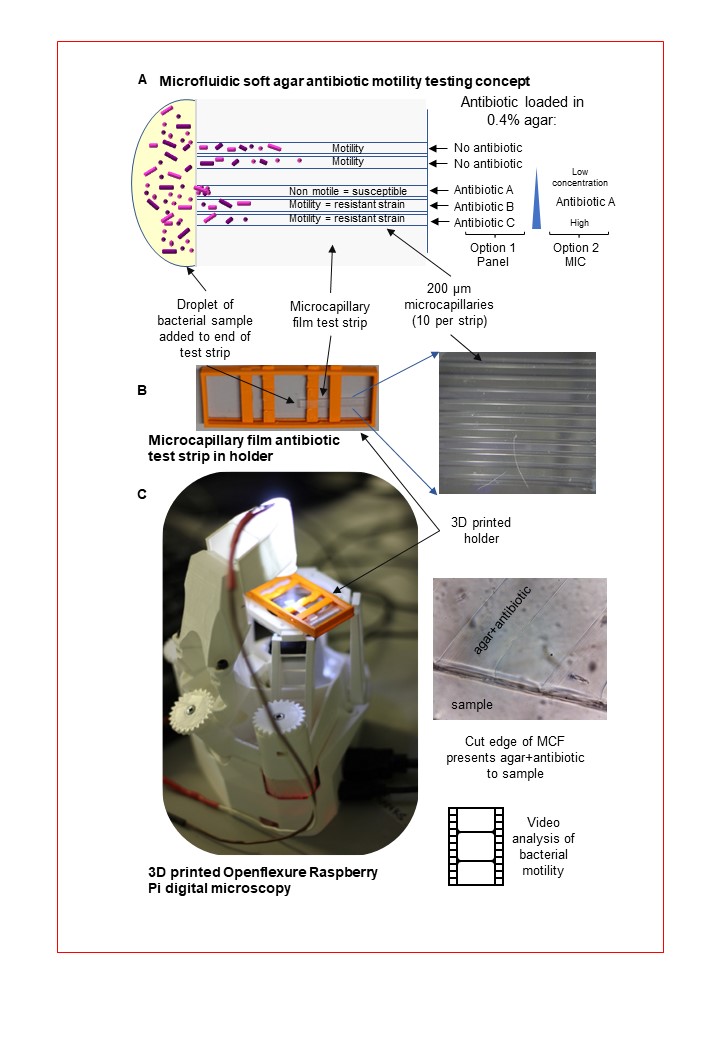Using Inexpensive 3D-Printed OpenFlexure Microscopy Allows Microfluidic Antibiotic Susceptibility Testing
- Abstract number
- 6
- Presentation Form
- Poster & Flash Talk
- DOI
- 10.22443/rms.mmc2023.6
- Corresponding Email
- [email protected]
- Session
- Public Health: The Impact of Microscopy
- Authors
- Dr Tai The Diep (1), Dr Samuel Bizley (1), Dr Alexander D. Edwards (1, 2)
- Affiliations
-
1. Reading School of Pharmacy, University of Reading, Reading RG6 6AD, UK
2. Capillary Film Technology Ltd., Billingshurst RH14 9TF, UK
- Keywords
antibiotic motility test; antimicrobial resistance; microfluidic; bacterial cytometry; digital microscope; 3D printing
- Abstract text
Antibiotic susceptibility testing is vital to tackle the emergence and spread of antimicrobial resistance. Inexpensive digital CMOS cameras can be converted into portable digital microscopes using 3D printed x-y-z stages. Microscopic examination of bacterial motility can rapidly detect the response of microbes to antibiotics to determine susceptibility. Here, we present a new simple microdevice-miniature microscope cell measurement system for multiplexed antibiotic susceptibility testing. The microdevice is made using melt-extruded plastic film strips containing ten parallel 0.2 mm diameter microcapillaries (Figure 1). Two different antibiotics, ceftazidime and gentamicin, were prepared in Mueller-Hinton agar (0.4%) to produce an antibiotic-loaded microdevice for simple sample addition. This combination was selected to closely match current standard methods for both antibiotic susceptibility testing and motility testing. Use of low agar concentration permits observation of motile bacteria responding to antibiotic exposure as they enter capillaries. This device fits onto the OpenFlexure 3D-printed digital microscope using a Raspberry Pi computer and v2 camera, avoiding need for expensive laboratory microscopes. The OpenFlexure microscope provides a low-cost, portable microscopy that combined with increasingly more affordable portable devices, such as microfluidic systems, can allow field use cytometry, for example as near-patient diagnostics, in this example illustrated by rapid antibiotic resistance detection. The microscope has sufficient resolution to identify individual bacteria under simple single-LED bright field illumination, and video recording can readily capture the motility of unstained bacteria in the microcapillaries used in this study. The increase in availability of microelectronics such as low-cost but high-quality optoelectronics combined with microfluidics, will drive the development of new portable diagnostic devices, improving healthcare needs in especially in rural or low-resource settings. We conclude that a 3D-printed Raspberry Pi-based microscope combined with disposable microfluidic test strips permit rapid, easy-to-use bacterial motility detection, with potential for aiding detection of antibiotic resistance.
Figure 1. Combining inexpensive microfluidics with 3D-printed digital microscopy to create a simple cytometer for observing response of motile bacteria to antibiotics. (A) Schematic of configuration of microcapillary film strip presenting different antibiotics, or different concentrations of a single antibiotic, to a bacterial sample. (B) Test strip is contained in simple holder with transparent base; each holder can present four strips each of ten conditions to a single drop of sample. (C) Combined with 3D-printed OpenFlexure microscope allows direct observation of how motile bacterial cells response to exposure to antibiotics.
- References
https: //github.com/rwb27/OpenFlexure_microscope
https:// picamera.readthedocs.io

